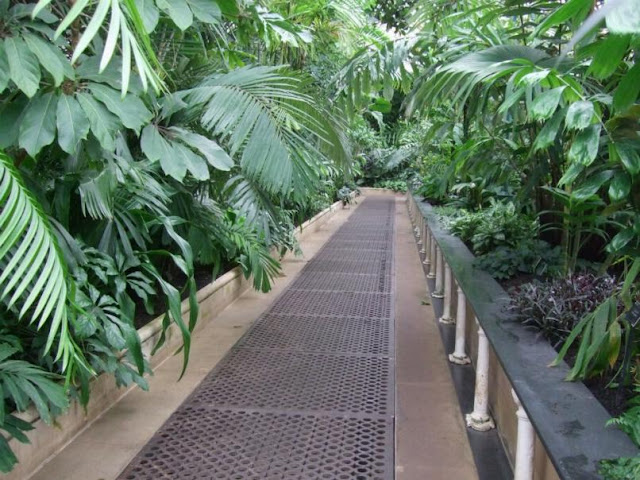Wednesday, November 07, 2012
Gaz
When we visited Kew a couple of weeks ago, we included a tour through the Palm House. Built between 1844 to 1848 its one of the most iconic looking Victorian Glasshouses and home to a fantastic collection of Palms, Cycads and other exotic plants. But on a cold day the warm and humid tropical conditions are a real draw and the lush exotic plants a wonderful escape from the cold autumnal weather outside.
We were fortunate when we visited that there were hardly anyone else in the Palm House, so at times it felt like we had the place to ourselves.
We have a growing passion for Cycads at the moment, the above being a fine example at Kew. Now all we need is a large glasshouse to keep them in.
Tropical Schefflera, whilst these are not hardy there's now plenty of hardy schefflera available in the UK to get the look.
 And more cycads...
And more cycads...

 |
| The Beehive Ginger (Zingiber spectabile). These almost look like they are made from plastic! |
 |
I do like the Victorian ironwork through the palm house, whilst more modern glasshouses may be
better designed in many regards the structural iron in a place like the Palm House is simply a delight on its own.
|

It is often reported that the designers of the Palm House were ship builders, hence the overall shape. I also like to think they truly were architects as the design is beautiful.
 |
| Intricate detail from a time when form was as important as function. |
 |
I wish there were more hardy aroids available, whilst plants such of these (Alocasia amazonica) can be
over wintered inside, we have enough other plants to look after without having too many smaller tender
plants.
 |
I was not paying close enough attention to get the name of this tree, (the tag being for an Orchid),
any suggestions as to what it is?
|
|
 |
| You can almost feel the heat and humidity in here |
 |
| A tropical bamboo, with Marks hand for scale. |
 |
| Fresh green growth giving us a reminder of Spring despite the Autumnal weather |
 |
| Non stop lush green growth |
The following plant (Cecropia) is one of my favourite plants in the palm house, and its not a palm, however that leaf shape and size makes it a worthy selection.
 |
| Taken from the balcony, and I didn't spot a name from this view. (but its a palm!) |
 |
| And from a different angle, name anyone? |
 |
| Another deserted view |
We have visited the Palm House at Kew dozens over times of the years, and whilst I must admit it can sometimes be easy to become a little blasé about it, there is always something special about a visit (even more so when its cold and miserable outside!).
Gaz





























 This gardening blog follows our journey as we create our Tropical and Exotic themed garden. We hope you'll enjoy the journey as much as we do. We started our Exotic Garden in 2005 and this site will show its development, as well as our travels, both abroad and within the UK to gardens, nurseries and friends.
This gardening blog follows our journey as we create our Tropical and Exotic themed garden. We hope you'll enjoy the journey as much as we do. We started our Exotic Garden in 2005 and this site will show its development, as well as our travels, both abroad and within the UK to gardens, nurseries and friends.














Just wonderful! Would love to get back over there sometime.
ReplyDeleteGlad you enjoyed it Deanne!
DeleteGreat pictures!
ReplyDeleteI took nearly that same photo of the tree and green fruit, with only the same Orchid label for ID, good to know I wasn't missing the obvious.
Glad its not just me, did you get the correct ID as well Loree?
DeleteI did not, but it looks like Missy might be on to something.
DeleteFun to see the Palm House from two viewpoints so close together. It is a beautiful building, Victorian at its best.
ReplyDeleteFor your palm in question, I thought "banana palm" but that turns out to apply to several different plants. That's the problem with learning common names for everything.
Hi Shirley, glad you enjoyed the tour, and yes the Palm house is an amazing Victorian structure
DeleteI cheated and googled but the tree looks like it might be a Calabash Tree (English) or Jicara (in Spanish)native to Central America.
ReplyDeleteHAven't got a clue with the Palm. So many look alike.
Thanks Missy, that could well be it. I'll have to check properly next time we are there.
DeleteSuper tour of the Palm House! The Cecropia is beautiful but my favorite picture is the one just before it of that gorgeous palm!
ReplyDeleteThanks Outlaw! Glad you enjoyed the tour. That palm is a stunner isn't it
DeleteThere is a Crescentia cujete in the Palm House
ReplyDeletehttp://www.flickr.com/photos/tralamander/6137622816/
So I think Missy is right.
Chad.
Thanks Chad
Delete